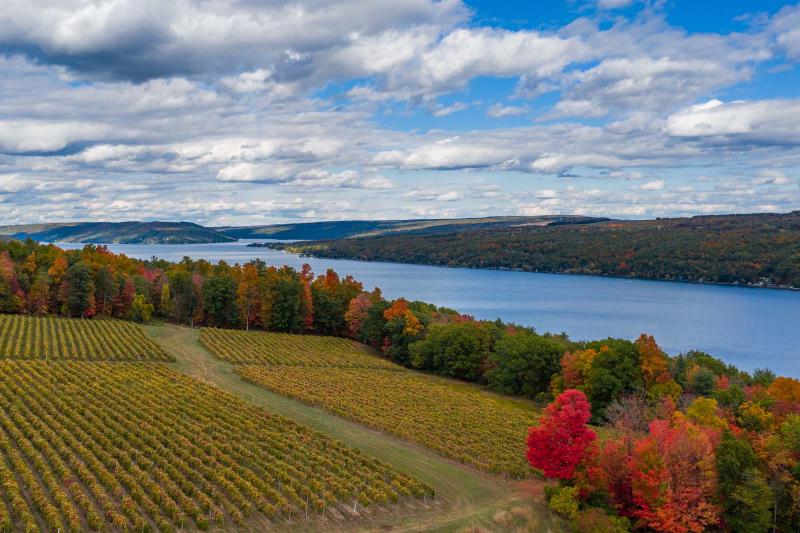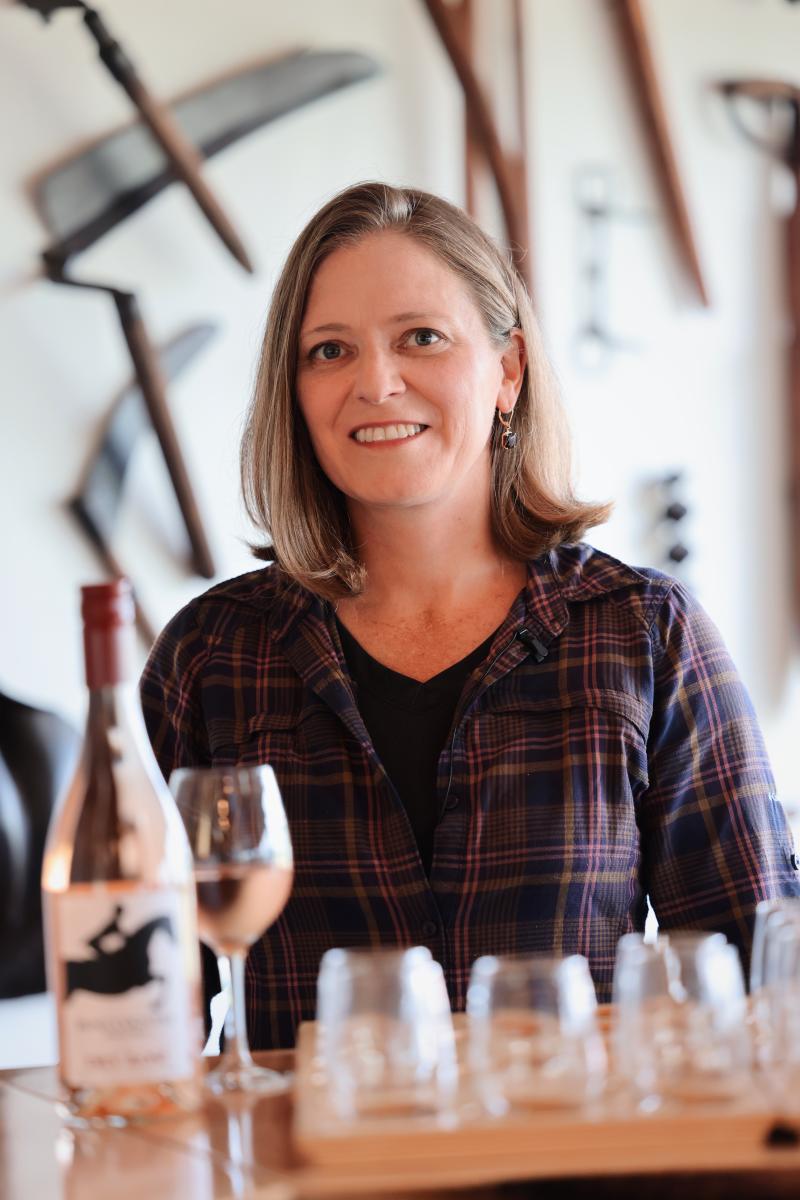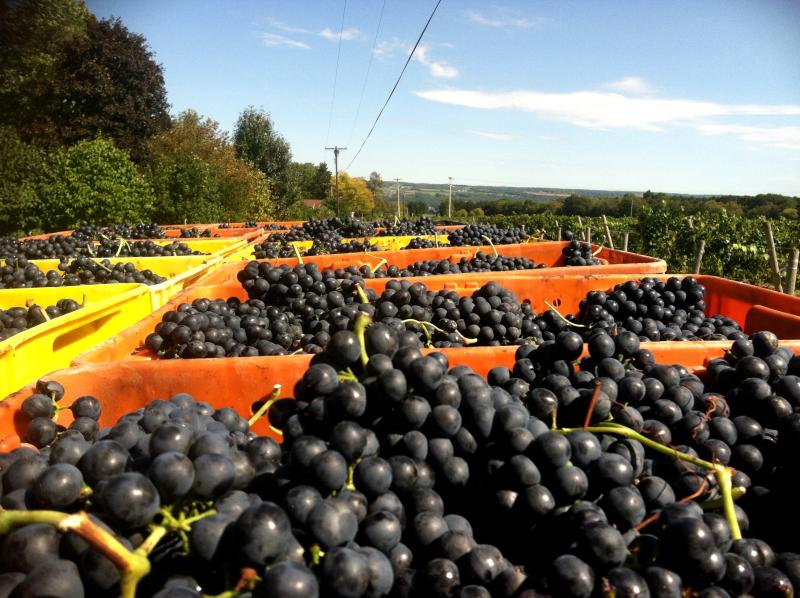
The Hunt family started crafting wine in 1981 and has been farming west of Keuka Lake in New York’s Finger Lakes region for seven generations. Hunt Country Vineyards is committed to responsible farming and caring for the land that gives us so much. They have reduced fossil fuel use by installing award-winning solar and geothermal systems. A portion of the vineyards are certified organic and several wines are made from organic grapes. Hunt Country Vineyard received the 2020 Sustainability Award from the New York Wine & Grape Foundation for its sustainability practices.
Growing up on the farm and with the winery inspired Suzanne Hunt’s passion for sustainability, climate solutions, and clean energy. She’s spearheaded a multitude of sustainability and climate resilience efforts. In 2021 Suzanne and her parents were recognized by Wine Business Monthly as some of the top leaders who shape the way the wine industry operates. In this interview, Suzanne shares ways others in the industry can work on being more sustainable.
Has Hunt Country Vineyards always been environmentally focused?
Suzanne Hunt: Yes, my parents bought the family farm from the previous generation in the 1970s because they wanted to live on the land. Environmental concerns have shifted somewhat over time. Decades ago, the key concerns for ecologically-minded farmers were things like DDT, erosion, and fertilizer leaching into water supplies. Nowadays the most pressing concerns include climate change, ‘forever chemicals’, invasive species, and loss of pollinators. Soil conservation has shifted to more complex considerations of soil health and soil as a tool in carbon sequestration and storage. Wildlife stewardship, erosion, and water quality concerns have been fairly consistent.
"The nuts-and-bolts of sustainable vineyard practices are waste reduction, energy and water conservation, and other essentials. But I would stress advocacy and customer education as well."
Which processes were easier to implement?
SH: Well, every change requires effort. But some of the things we’ve done that are relatively straightforward and not difficult include: using only compost and manure as fertilizer instead of synthetic fertilizers, switching to efficient LED lighting, using eco-flooring and other eco-building materials, using lightweight/eco glass bottles, recycling, installing bird and bat boxes, and planting pollinator habitat.
What were some of the more challenging processes you experienced making the shift to a more environmentally focused vineyard?
SH: We have struggled with weed control in our certified organic vineyards. With a permanent crop like vines, we don’t have as many tools in our toolkit as our organic farmer friends who grow annual crops and can rotate crops and so on.
We were the first large complex geothermal system that the local companies had installed over a decade ago when we invested in a geothermal system to heat and cool all of our large buildings. The installers were learning as they went so we’ve had a lot more challenges with our geothermal system than folks will have now that there are more experienced installers, and better quality equipment that comes with diagnostic tools to target maintenance.
When we installed 348 solar panels on our building roofs in 2015, it took quite a lot of time and effort. Our local banks had never financed large commercial solar power systems so we arranged for the President of the NY Green Bank and some of his staff to spend an afternoon fielding their questions related to warranties, equipment depreciation, etc. Getting the permits was also much more of a struggle than it should have been.
We’ve had a harder time because we’ve been making these changes before they were common practice. It will be easier for other businesses that make the investments now.
What do you think are some of the most important practices of an environmentally focused winery?
SH: There are the nuts-and-bolts sustainable vineyard practices, waste reduction, energy and water conservation, and other essentials. But I would stress advocacy and customer education as well. The environmental challenges we face require direct action. Changing practices on our farms and in our businesses as well as society-wide approaches. Many of these environmental challenges are system-wide and societal challenges that require policy, regulatory, and systems changes.
As a highly visible industry, our voices as business leaders carry weight. We need to use them. And, we are also a rare part of farming where the public actually comes to spend time at our farms, which is an opportunity to help raise awareness and activate our customers.
Back to the nuts and bolts: farming involves challenging physical and economic conditions that are constantly changing – so it’s important to focus on constant improvement as our scientific knowledge expands and the tools available to us evolve. It is also critical to focus on practices that will enhance the resilience of your operation as well as provide environmental benefits. A good example of a practice that achieves multiple goals, including enhancing resilience to extreme dry and extreme wet conditions (which will worsen as climate change intensifies), is enhancing soil organic matter.
The new New York State Sustainable Winegrowing certification program is a good place to start. Growers and wineries can go through hundreds of aspects of their business and identify areas for improvements related to environmental impacts but also safety and other social and economic sustainability metrics.

What other local (or national) wineries are doing the work?
SH: We are the first New York winery to join the International Wineries for Climate Action (IWCA) organization that was co-founded by two large international wineries: Torres Family Winery (from Spain) and Jackson Family Winery (headquartered in California). But the IWCA has members of all sizes including Cakebread Cellars, Opus One, and other well-known brands. To become a member you have to go through a rigorous greenhouse gas accounting process and third-party audit.
About a dozen New York winery owners serve on the New York Wine and Grape Foundation’s Sustainability Advisory Committee which I chaired until recently. We have spent the past several years developing and testing out a sustainability certification program designed for New York grape and wine producers. Currently, we, and several dozen other Finger Lakes producers, are in the process of getting certified. Soon New York wine drinkers will start seeing the New York Sustainable Winegrowing ‘Trustmark’ on our websites, social media posts, and eventually bottle labels.
What do people need to look out for to confirm if a winery has sustainable practices?
SH: Consumers can look for trust marks but until now we didn’t have a comprehensive sustainability certification that was relevant to New York wine growers. So the most important thing consumers can do is ask questions and get to know the wineries that they frequent. Read articles like this and educate yourself on who the leaders are and support them!
“Every generation that came before us had to innovate to succeed in farming and business. We are no different, but the pace of change is accelerating, making innovation even more critical to our ability to succeed.”
What inspired your passion for climate solutions and clean energy?
SH: This place. Growing up on the farm and with the winery. It was really hard-going for my parents when I was a kid. They, and their contemporaries, were building a New York wine industry almost from the ground up after the grape market crashed. They made sure my siblings and I could follow our passions and mine was always the environment.
I was able to get degrees in Environmental Science, Natural Resources Management, and International Affairs and work in the environmental field all over the world before returning home. I still work in sustainable infrastructure, agriculture, and transportation-related policy. Although you could argue that having two full-time jobs is not sustainable!
Why is innovation so important?
SH: Farming has always been hard. Nowadays the impacts of climate change, labor shortages, economic crises, and other disruptions are making it even harder. Every generation that came before us had to innovate to succeed in farming and business. We are no different, but the pace of change is accelerating, making innovation even more critical to our ability to succeed.
What are some ways Hunt Country Vineyards has had to innovate?
SH: So many ways! The winery was an innovation in response to the grape market crash. In the 1970’s after the grape market crashed my parents learned how to make wine out of the hundreds of tons of grapes they couldn’t sell. Not all of the varieties that they were growing were desirable for winemaking, but the vineyards were the collateral on the loans they took out to plant the vines so they couldn’t rip them out. So my dad worked with Cornell and pioneered cold climate field grafting and grafted new varieties onto some of the existing vineyards.
In the 1980’s our ice wine bottles were too small for our labeling machine so my dad attached an electric motor to a manual labeler from 1910. There are countless examples like that. My mom helped start up several Finger Lakes wine promotion organizations and programs.
Most recently, the release of our Uncharted Terroir (UT) line of wines is an innovation in response to the unpredictable impacts of climate change. Our UT wines are made from hybrid grape varieties that have typically been looked down on in the wine world. But when you give these grapes the same love and attention as their vinifera cousins, you can make outstanding wines.
Hybrid grapes are far more resilient and rugged than vinifera grapes, so they can withstand and bounce back from the increasingly frequent extreme weather events we are facing. For example, the surprise frost in May 2023 that hammered vineyards in New York devastated our Cabernet Franc, Chardonnay, and Riesling. But our Vidal Blanc and Vignoles look like they’ll still give us a significant crop.

What advice can you offer smaller wineries that don’t have huge budgets to invest in large sustainability-focused infrastructures/processes, but want to be more environmentally conscious?
SH: Work with your local soil and water department. They can often help with technical assistance and potentially partner on grants to help test out or implement new practices. Right now we are working with our local soil and water department on a project to study the effects of adding compost and biochar to our vineyards and hay fields funded in part by a climate-smart agriculture grant. We are also working with them, along with some of our neighbors, to test out an under-the-row mower.
Develop a strong relationship with a local bank so that you can use loans to pay for some of the investments with shorter payback periods. Develop partnerships. For example, we partnered with Tesla to install five electric vehicle charging stations in our parking lot.
In what ways are you looking to expand in the future?
SH: We’re always looking for new ways – big and small - to improve. My dad is always tweaking, and even inventing new machines and strategies to try to improve practices in the vineyards. We’ve worked closely with researchers at Cornell over the decades on improved management strategies and will continue that collaboration.
From a climate impact perspective, packaging is one of the biggest sources of greenhouse gas emissions from the wine industry. Glass manufacturing requires an enormous amount of heat, and in the U.S. right now that heat is supplied primarily by fossil fuels. I’m in the very early stages of working with large wineries to try to create enough demand to get our glass suppliers to work with the government and renewable fuel suppliers to slash their emissions. We’re also always working on phasing in electric vehicles.
In collaboration with scientists at the US Department of Agriculture, we are going to plant a 5-acre field next to the forest on our farm with wildflowers to support native pollinator populations – many of which are ground-dwelling and benefit from proximity to forest habitat. We’ll manage the field to keep in wildflowers into the future.
From a broader ‘what people need right now’ perspective, we are focusing on getting people here for hands-on (phones off) workshops and retreats focused on skills development, enhancing well-being, community building, and problem-solving.
Our advocacy is focused on the implementation of the New York climate law and on the conservation title of the federal Farm Bill which is only renewed once every five years.
In addition to being a co-owner of her family's seventh-generation farm and winery, Suzanne Hunt is the Vice President for Public Policy for Generate Upcycle, PBC which finances, builds, owns, and operates sustainable infrastructure projects in North America and Europe.





